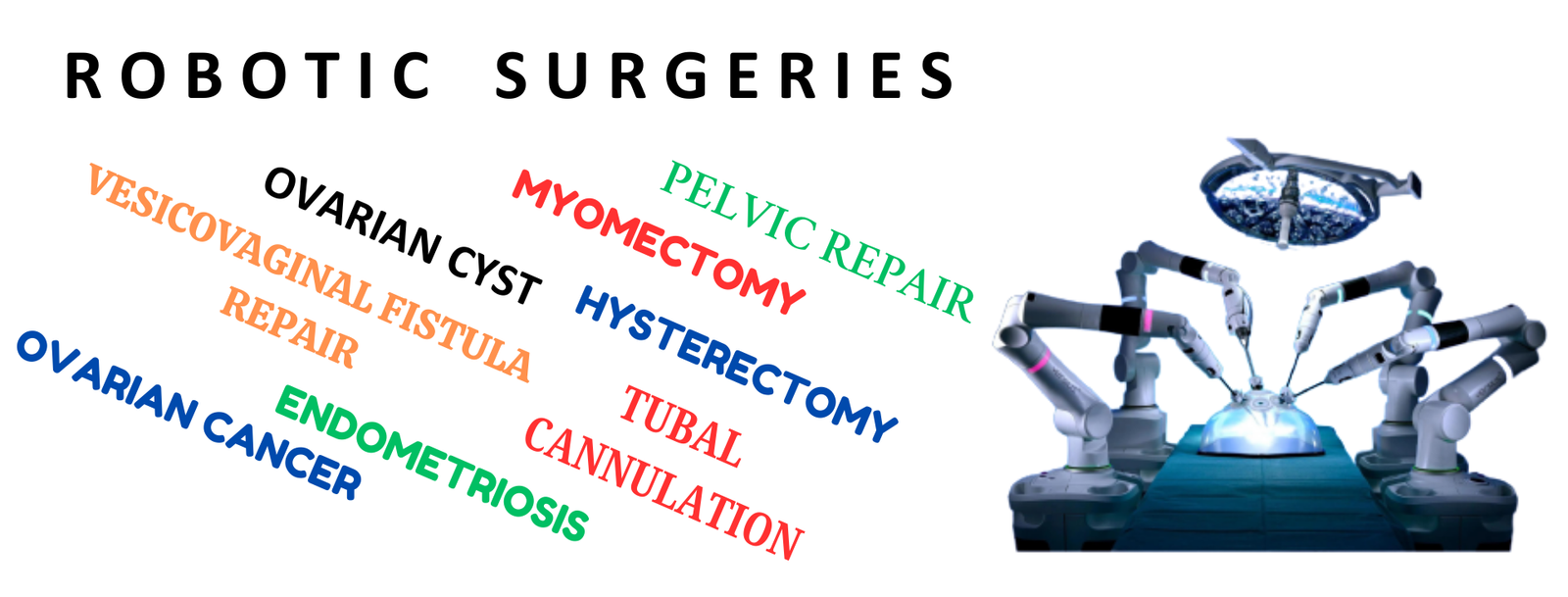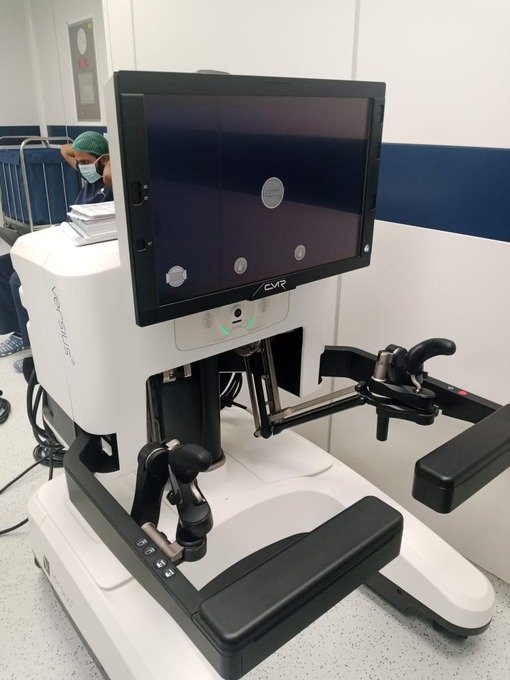

Robotic surgery is also known as robot assisted surgery which refers to surgical procedures that are performed with the assistance of robotic systems. These systems allow surgeons to perform many types of complex procedures with more precision, flexibility and control than in conventional techniques.
Robotic Surgery is a surgical procedure in which a surgeon uses a computer to control small instruments attached to a robotic arm. The surgeon operates from a console, viewing the surgical site through a high definition, magnified, 3D camera system. The robotic system translates the surgeon's hand movements into precise movements of the instruments inside the patient's body. The primary intent of robotic surgery is to enhance the capabilities of surgeons and improve surgical outcomes through increased precision, dexterity and access along with potential to perform less invasive procedures. Robotic surgery can be applied to a range of surgical specialties, including urology, gynecology, thoracic surgery, and more.


Advanced Imaging
Integrated Real Time Imaging: Combines traditional surgical views with real-time scans like MRI or ultrasound.

Dexterity and Precision
User Experience
Safety
Augmented Reality
Advanced visual aids to highlight key anatomical features or surgical targets.
These features contribute to the capabilities of robotic surgery systems, enhancing the precision, control, and safety of surgical procedures.
Robotic surgery systems are composed of several key components that work in tandem to assist surgeons in performing complex procedures with precision and control. The following are the primary components of a typical robotic surgical system:
Surgeon's Console
Surgeon's Console: This is where the surgeon sits during the procedure. The console is equipped with controls that the surgeon uses to manipulate the robotic arms and instruments. The console typically features a high-definition, 3D monitor that offers a magnified view of the surgical site, allowing the surgeon to operate with enhanced visibility and precision.
Robotic Arms and Instruments
Camera and Imaging
3D High-definition Camera: One of the robotic arms holds a camera that sends a high-definition, 3D image to the surgeon's console, providing a detailed and magnified view of the surgical area.
Patient-side Cart
Patient-side Cart: This cart is positioned next to the operating table and holds the robotic arms and instruments. It may also house other components like the power supply and other hardware.
Control System
Control System: This is essentially the "brain" of the robot, controlling the movements of the robotic arms and instruments in response to the inputs from the surgeon's console. It also incorporates safety features like tremor reduction and motion scaling, which makes the surgeon's hand movements more precise.
Additional Features
Each component is designed to offer particular advantages like enhanced dexterity, precision, and control to improve the outcomes of surgical procedures.
Robotic surgery offers a range of benefits compared to traditional open surgery and even laparoscopic techniques. These benefits can be important for both surgeons and patients:
Smaller Incisions: Robotic surgery often requires smaller incisions, reducing scarring and post-operative pain.
Shorter Hospital Stay: The minimally invasive nature often leads to shorter hospital stays.
Quicker Return to Normal Activities: Faster healing allows patients to resume their normal routines more quickly.
Lower Pain Medication Needs: Smaller incisions and less tissue trauma can mean less pain post-surgery, reducing the need for pain medications.
Smaller Open Areas: The less invasive technique may reduce the risk of post-operative infections.
Precision: The enhanced control and visibility can lead to more precise removal of tumors or reconstruction, improving clinical outcomes.
3D High-Definition Imaging: Offers surgeons a better view of the surgical site than traditional laparoscopic or open surgery.
EndoWrist Instruments: The flexible and articulated instruments provide a range of motion that exceeds human capabilities in some aspects.
Comfortable Console: Surgeons can sit during the procedure, reducing fatigue and increasing focus during long surgeries.
Motion Scaling: The robotic system refines the surgeon's movements, allowing for extremely precise manipulations.
Access to Difficult Areas: The flexibility and control of the robotic system can enable procedures that are challenging or not possible through traditional methods.
Teaching and Training
Safety
Scalability and Versatility
Multiple Specializations: Can be used across a range of surgical specialities including urology, cardiology, gynecology, and more.
While robotic surgery offers many advantages, it's essential to note that it is not suitable for all types of surgeries or all patients. Furthermore, the high cost of robotic surgery systems can be a limiting factor for many healthcare facilities.
Robotic surgery and laparoscopic surgery are both minimally invasive techniques, but robotic surgery offers several advantages over traditional laparoscopic surgery. Here are some of the benefits of robotic surgery when compared to laparoscopic surgery:
Enhanced Visualization
3D High-Definition Imaging: Robotic systems often provide superior, high-definition, 3D visualization, as compared to the 2D view in laparoscopic systems. This enhanced view can improve the surgeon's ability to navigate the surgical site.
Greater Dexterity and Precision
Ergonomic Benefits for Surgeons
Advanced Maneuverability
Better Access to Tight Spaces: The increased dexterity and flexibility of robotic instruments can be advantageous when working in tight anatomical spaces where laparoscopic instruments may be limited.
Safety Enhancements
Expanded Range of Procedures
Broader Applications: The enhanced capabilities of robotic systems may make them suitable for complex surgeries that are challenging to perform laparoscopically.
Teaching and Collaboration
Dual Consoles: Some robotic systems offer a second console that allows another surgeon or a trainee to observe or participate in the surgery, something not easily achieved in traditional laparoscopic setups.
Consistency
Reproducible Movements: The precision offered by robotic systems can lead to more consistent surgical outcomes, especially in tasks that demand high levels of accuracy.
While robotic surgery offers these advantages, it's worth mentioning that it is generally more expensive than laparoscopic surgery. Additionally, the benefits must be weighed against the specific needs of the procedure and the patient, as robotic surgery is not suitable for every type of surgery or patient condition.
Robotic surgery, a type of minimally invasive surgery, offers several advantages over traditional open surgery. However, it's not suitable for everyone. Here's a brief overview of who might be a good candidate for robotic surgery:
Some procedures require very precise movements that might be hard to achieve with human hands alone. Robotic assistance can provide the necessary precision, especially in confined or delicate areas.
Robotic surgery typically involves smaller incisions than traditional open surgery. This can result in less blood loss, reduced pain, and faster recovery.
Not all conditions or surgeries are suitable for robotic approaches. However, if a condition is treatable with robotic surgery, such as prostate surgery, hysterectomy, or heart surgeries, patients might consider this option.
The smaller incisions of robotic surgery often lead to less scarring compared to traditional surgical methods.
Minimally invasive surgeries, including robotic surgeries, often result in shorter hospital stays and faster return to normal activities.
The smaller incisions and less invasive nature of robotic surgery can lead to reduced pain and less need for pain medications.
It's essential to have an in-depth discussion with a healthcare provider to determine the suitability of robotic surgery based on an individual's specific condition, health status, and other factors. The benefits and risks should be weighed carefully before making a decision.
Prof Dr Rehana Aamer Khan is the only gynecological robotic surgeon of Pakistan. She is doing all the complex gynecological robotically in Lahore. Here is the brief description of various gynecological procedures that she is doing robotically in Lahore.
Robotic Hysterectomy:A procedure where the uterus is removed using robotic assistance. This can be partial, total, or radical, depending on whether the cervix or surrounding structures are also removed. Robotic assistance provides increased precision and visualization compared to traditional methods.
Robotic Myomectomy:This is the surgical removal of fibroids from the uterus. The robotic approach offers enhanced dexterity, allowing the surgeon to remove fibroids with minimal damage to the surrounding uterine tissue.
Robotic Salpingectomy: A procedure to remove one or both fallopian tubes. Commonly done for ectopic pregnancy or as a preventive measure against certain types of cancer. Robotic assistance ensures precision and minimal tissue trauma.
Robotic Oophorectomy: The surgical removal of one or both ovaries. Robotic technology allows for improved visualization and meticulous dissection, reducing the risk of complications.
Robotic Sacrocolpopexy: Used to correct vaginal vault prolapse, this procedure involves attaching the top of the vagina to the sacrum using mesh. The robot's precision aids in accurate mesh placement.
Robotic Endometriosis Resection:Involves removing endometrial tissue growing outside the uterus. Robotic surgery offers a clearer view of the pelvic cavity and improved instrument maneuverability, enabling precise tissue removal.
Robotic Cystectomy:A procedure to remove ovarian cysts. The magnified 3D view and dexterity provided by the robot allow for accurate dissection and preservation of ovarian tissue.
Robotic Pelvic Floor Repair:A groundbreaking procedure, Robotic Pelvic Floor Repair addresses pelvic organ prolapse using advanced robotic technology.
Robotic Radical Hysterectomy: Robotic Radical Hysterectomy is a sophisticated procedure that involves the removal of the uterus, surrounding tissues, and occasionally nearby lymph nodes, predominantly for treating cancer.
Robotic Lymphadenectomy: This procedure focuses on the surgical removal of lymph nodes using state-of-the-art robotic systems. Primarily performed to assess cancer spread or treat certain gynecological cancers.
Robotic Tubal Reanastomosis:A cutting-edge solution for women seeking to reverse tubal ligation for fertility restoration. The Robotic Tubal Reanastomosis employs robotic technology for reconnecting the fallopian tubes with heightened accuracy, enhancing the chances of successful pregnancy post-procedure.
Each of these robotic procedures provides advantages like smaller incisions, reduced blood loss, and quicker recovery times compared to traditional surgeries. However, the decision to opt for robotic surgery should be based on individual patient needs, the surgeon's expertise, and available facilities.
Prof. Dr. Rehana Aamer Khan stands as a luminary in the realm of gynecological surgery, particularly in the field of robotic procedures, in Lahore. Her mastery in harnessing cutting-edge robotic systems has positioned her at the forefront of medical innovation in the region. Prof. Khan's vast experience and unparalleled expertise enable her to tackle an array of complex gynecological conditions with remarkable precision and confidence. In a city like known for its medical prowess, Prof. Khan has carved a niche for herself as the best robotic surgeon in Lahore. Her approach to each surgery is a blend of technical mastery and compassionate care, ensuring optimal outcomes with minimized patient discomfort. She is adept at handling a wide spectrum of procedures, from intricate myomectomies to advanced hysterectomies, showcasing her versatility and depth of knowledge in Lahore.
Patients across Lahore and beyond seek her expertise, drawn not only to her surgical proficiency but also her ability to demystify complex medical concepts, making them easily comprehensible. Her dedication to her craft, coupled with an unwavering commitment to patient well-being, has solidified Prof. Dr. Rehana Aamer Khan's reputation as the go-to robotic surgeon for complex gynecological surgeries in Lahore. Her contributions to the field continue to set the gold standard for surgical excellence in Lahore.
In the heart of Lahore, PKLI stands as the pinnacle of surgical innovation and expertise. We pride ourselves on being the premier destination for robotic surgeries, harnessing state of the art technology to ensure precision and optimal patient outcomes. Our world class surgeons, combined with cutting edge robotic systems, set us apart, offering procedures characterized by minimal invasiveness and enhanced recovery in Lahore. For those seeking the very best in surgical care, our institution represents the confluence of advanced technology and medical brilliance. We are not just a healthcare facility; we are the future of surgical excellence in Lahore.